Related Research Articles
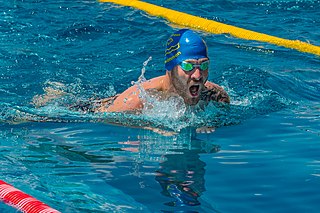
Swimming is the self-propulsion of a person through water or other liquid, such as saltwater or freshwater environments, usually for recreation, sport, exercise, or survival. Swimmers achieve locomotion by coordinating limb and body movements to achieve hydrodynamic thrust that results in directional motion. Newborns can instinctively hold their breath underwater and exhibit rudimentary swimming movements as part of a survival reflex. Swimming requires endurance, skill, and efficient techniques to maximize speed and minimize energy consumption.
Treading water or water treading is what a swimmer can do while in a vertical position to keep their head above the surface of the water, while not providing sufficient directional thrust to overcome inertia and propel the swimmer in any specific direction. As it expends less energy than traditional strokes, it is often used by swimmers to rest in between periods of exertion without having to leave the water.

The butterfly is a swimming stroke swum on the chest, with both arms moving symmetrically, accompanied by the butterfly kick along with the movement of the hips and chest. It is the newest swimming style swum in competition, first swum in the early 1930s and originating out of the breaststroke.

Breaststroke is a swimming style in which the swimmer is on their chest and the torso does not rotate. It is the most popular recreational style due to the swimmer's head being out of the water a large portion of the time, and that it can be swum comfortably at slow speeds. In most swimming classes, beginners learn either the breaststroke or the freestyle first. However, at the competitive level, swimming breaststroke at speed requires endurance and strength comparable to other strokes. Some people refer to breaststroke as the "frog" stroke, as the arms and legs move somewhat like a frog swimming in the water. The stroke itself is the slowest of any competitive strokes and is thought to be the oldest of all swimming strokes.

Backstroke or back crawl is one of the four swimming styles used in competitive events regulated by FINA, and the only one of these styles swum on the back. This swimming style has the advantage of easy breathing, but the disadvantage of swimmers not being able to see where they are going. It also has a different start from the other three competition swimming styles. The swimming style is similar to an upside down front crawl or freestyle. Both backstroke and front crawl are long-axis strokes. In individual medley backstroke is the second style swum; in the medley relay it is the first style swum.
Human swimming typically consists of repeating a specific body motion or swimming stroke to propel the body forward. There are many kinds of strokes, each defining a different swimming style or crawl.

Medley swimming is a combination of four different swimming strokes into one race. This race is either swum by one swimmer as individual medley (IM) or by four swimmers as a medley relay.

Swimfins, swim fins, diving fins, or flippers are finlike accessories worn on the feet, legs or hands and made from rubber, plastic, carbon fiber or combinations of these materials, to aid movement through the water in water sports activities such as swimming, bodyboarding, bodysurfing, float-tube fishing, kneeboarding, riverboarding, scuba diving, snorkeling, spearfishing, underwater hockey, underwater rugby and various other types of underwater diving.

Open water swimming is a swimming discipline which takes place in outdoor bodies of water such as open oceans, lakes, and rivers. Competitive open water swimming is governed by the International Swimming Federation, World Aquatics, except when it is part of multi-sport events, which are governed by the World Triathlon.
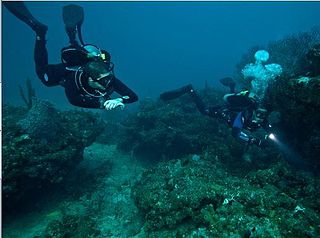
Finning techniques are the skills and methods used by swimmers and underwater divers to propel themselves through the water and to maneuver when wearing swimfins. There are several styles used for propulsion, some of which are more suited to particular swimfin configurations. There are also techniques for positional maneuvering, such as rotation on the spot, which may not involve significant locational change. Use of the most appropriate finning style for the circumstances can increase propulsive efficiency, reduce fatigue, improve precision of maneuvering and control of the diver's position in the water, and thereby increase the task effectiveness of the diver and reduce the impact on the environment. Propulsion through water requires much more work than through air due to higher density and viscosity. Diving equipment which is bulky usually increases drag, and reduction of drag can significantly reduce the effort of finning. This can be done to some extent by streamlining diving equipment, and by swimming along the axis of least drag, which requires correct diver trim. Efficient production of thrust also reduces the effort required, but there are also situations where efficiency must be traded off against practical necessity related to the environment or task in hand, such as the ability to maneuver effectively and resistance to damage of the equipment.

Creeking is a branch of canoeing and kayaking that involves descending very steep low-volume whitewater. It is usually performed in specialized canoes and kayaks specifically designed to withstand the extreme whitewater environment in which the activity occurs. In addition, the canoes and kayaks give the paddler improved performance and maneuverability needed to avoid river obstacles.

A hand paddle is a device worn by swimmers during training. It consists of a plastic plate worn over the swimmer's palm and attached over the back of the swimmer's hand with elastic cords. The plate is often perforated with a pattern of holes.
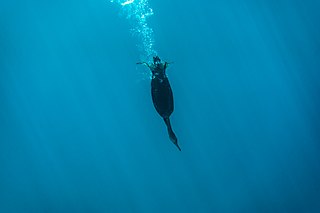
Aquatic locomotion or swimming is biologically propelled motion through a liquid medium. The simplest propulsive systems are composed of cilia and flagella. Swimming has evolved a number of times in a range of organisms including arthropods, fish, molluscs, amphibians, reptiles, birds, and mammals.
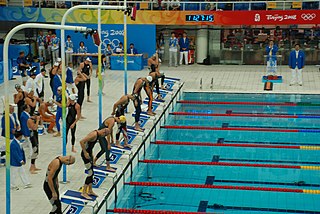
Swimming is an individual or team racing sport that requires the use of one's entire body to move through water. The sport takes place in pools or open water. Competitive swimming is one of the most popular Olympic sports, with varied distance events in butterfly, backstroke, breaststroke, freestyle, and individual medley. In addition to these individual events, four swimmers can take part in either a freestyle or medley relay. A medley relay consists of four swimmers who will each swim a different stroke, ordered as backstroke, breaststroke, butterfly and freestyle.

The front crawl or forward crawl, also known as the Australian crawl or American crawl, is a swimming stroke usually regarded as the fastest of the four front primary strokes. As such, the front crawl stroke is almost universally used during a freestyle swimming competition, and hence freestyle is used metonymically for the front crawl. It is one of two long axis strokes, the other one being the backstroke. Unlike the backstroke, the breaststroke, and the butterfly stroke, the front crawl is not regulated by the FINA. Hence, in "freestyle" competitive swimming events, any stroke or combination of strokes is permissible. This style is sometimes referred to as the Australian crawl although this can sometimes refer to a more specific variant of front crawl.

Freestyle is a category of swimming competition, defined by the rules of World Aquatics, in which competitors are subject to only a few limited restrictions on their swimming stroke. Freestyle races are the most common of all swimming competitions, with distances beginning with 50 meters and reaching 1,500 meters, also known as the mile. The term 'freestyle stroke' is sometimes used as a synonym for 'front crawl', as front crawl is the fastest surface swimming stroke. It is now the most common stroke used in freestyle competitions.

Swimming has been recorded since prehistoric times; the earliest recording of swimming dates back to Stone Age paintings from around 7,000 years ago. In 1578, Nikolaus Wynmann, a German professor of languages, wrote the first swimming book.
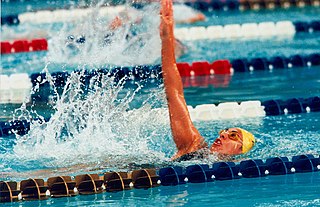
S8, SB7, SM8 are para-swimming classifications used for categorizing swimmers based on their level of disability. This class includes a number of different disabilities including people with amputations and cerebral palsy. The classification is governed by the International Paralympic Committee, and competes at the Paralympic Games.

S7, SB6, SM7 are para-swimming classifications used for categorizing swimmers based on their level of disability. Swimmers in this class have use of their arms and trunk. They have limited leg function or are missing a leg or parts of both legs. This class includes a number of different disabilities including people with amputations and cerebral palsy. The classification is governed by the International Paralympic Committee, and competes at the Paralympic Games.
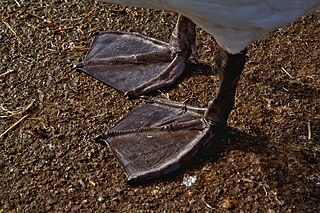
The webbed foot is a specialized limb with interdigital membranes (webbings) that aids in aquatic locomotion, present in a variety of tetrapod vertebrates. This adaptation is primarily found in semiaquatic species, and has convergently evolved many times across vertebrate taxa.
References
- ↑ William Clarke (1881). Boys' Own Book: A Complete Encyclopedia of Athletic, Scientific, Outdoor and Indoor Sports. J Miller.
- ↑ Carl Zimmer (1999). At the Water's Edge: Fish with Fingers, Whales with Legs, and How Life Came Ashore But Then Went Back to Sea. Simon & Schuster. p. 183. ISBN 0-684-85623-9.
- ↑ Cecil Colwin (2002). Breakthrough Swimming: Stroke Mechanics, Training Methods, Racing Techniques. Human Kinetics. p. 12. ISBN 0-7360-3777-2.
- ↑ Greg Kehm (2007). Olympic Swimming and Diving. Rosen. p. 4. ISBN 978-1-4042-0970-1.
- ↑ H. Manners, M. E. Carroll (1995). A Framework for Physical Education in the Early Years. Routledge. p. 110. ISBN 0-7507-0417-9.
- ↑ U.S. Departments of the Army and Air Force (1950). Survival at Sea. United States Government Printing Office. p. 58.